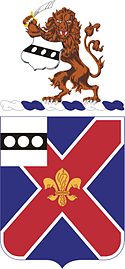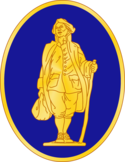| 111th Infantry Regiment | |
|---|---|
 Coat of arms | |
| Active | 1747[1] |
| Allegiance | Commonwealth of Pennsylvania |
| Branch | Army National Guard |
| Type | Infantry |
| Role | Stryker |
| Garrison/HQ | 1st Battalion - Plymouth Meeting, PA |
| Nickname(s) | The Associators (Special Designation) [2] |
| Motto(s) | "Nulla Vestigia Retrorsum" (No Step Backward)[3] |
| Engagements | Revolutionary War War of 1812 American Civil War Spanish–American War World War I World War II Operation Noble Eagle(Kosovo Force) Operation Iraqi Freedom |
| Commanders | |
| Current commander | Major David W. Fittipoldi |
| Notable commanders | John Cadwalder Edward C. Shannon |
| Insignia | |
| Distinctive unit insignia |  |
| U.S. Infantry Regiments | ||||
|
The 111th Infantry Regiment, was originally the Pennsylvania Militia or "Associators" that fought in the American Revolution, composed of civilian males from the citizenry of Pennsylvania. It is one of several National Guard units with colonial roots and campaign credit for the War of 1812. The Pennsylvania Militia often fought in conjunction with General Washington and the Continental Army along the Delaware River. Today the idea of a Pennsylvania Militia is represented in the U.S. Army by 1st Battalion, 111th Infantry assigned to the Pennsylvania Army National Guard's 56th Stryker Brigade Combat Team, 28th Infantry Division.[4] The regiment, founded as the Associators by Benjamin Franklin in Philadelphia, Pennsylvania on 21 November 1747, is the oldest regiment in Pennsylvania.[3]
In February 1942, the 111th Regiment was detached from the 28th Infantry Division and re-formed as a regimental combat team in the Army Ground Forces Reserve, attached to the Eastern Defense Command at Camp Pendleton, Virginia to guard militarily important facilities in the Chesapeake Bay area.[5] From this assignment, it was transferred to the Pacific Theater in late 1943. Throughout the rest of the war, the companies of the 111th would be used as replacement or additional units in combat conditions. The Third Battalion of the 111th was used for mopping up operations on Makin Atoll in the Gilbert Islands in December 1943. The 111th B Company was assigned to the Seventh Cavalry Reconnaissance Troop of the Seventh Division for the assault on Kwajalein Island in February 1944. In other actions, I Company of the 111th was involved in assaulting and capturing Ujeland Atoll in the Marshall Islands in April 1944. And in September 1944, both the D and H Companies were assigned to the 81st Division for an attack on Peleliu and Auguar Islands in the Palaus chain. Later, in February 1945, the entire 111th returned to Peleliu Island for mopping-up operations. When the war ended in September 1945, the 111th had added three battle streamers, Central Pacific, Eastern Mandate and Western Pacific, for a total of 38 on its flag.[6][7][8][9]
The 1st Battalion, 111th Infantry Regiment was awarded the Meritorious Unit Commendation[10] - Operation Iraqi Freedom.

REVOLUTIONARY WAR
WAR OF 1812
CIVIL WAR
WAR WITH SPAIN
WORLD WAR I
WORLD WAR II
KOSOVO
IRAQ
A Gold color metal and enamel device 1+1⁄4 inches (3.2 cm) in height overall consisting of an oval Azure a reproduction of the statue of Benjamin Franklin, by R. Tait McKenzie, affronté Or.
The field is blue for Infantry. Benjamin Franklin was the organizer of the "Associators", to which organization the 111th Infantry traces its history.
The distinctive unit insignia was approved on 27 June 1929.
Azure, on a saltire Argent voided Gules a fleur-de-lis Or; on a canton of the second a fess Sable charged with three plates.
That for the regiments and separate battalions of the Pennsylvania Army National Guard: On a wreath of the colors Argent and Azure, a lion rampant guardant Proper holding in dexter paw a naked scimitar Argent, hilted Or, and in sinister an escutcheon Argent on a fess Sable three plates. Motto NULLA VESTIGIA RETRORSUM (No Steps Backward).
The shield is blue for Infantry. The saltire is for the Civil War service and the fleur-de-lis for World War I service. The canton represents the shield that appeared on the "Associators'" flag, indicating the Revolutionary War service of the organization. The silver saltire has been voided with red in similitude to the colors of the uniforms of the Pennsylvania troops as prescribed by General Washington in 1779. The motto was used by the 3d Infantry, Pennsylvania National Guard, for a number of years.
The crest is that of the Pennsylvania Army National Guard.
The coat of arms was approved on 13 June 1929